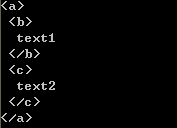Beautiful Soup是python的一个库,最主要的功能是从网页抓取数据
Beautiful Soup提供一些简单的、python式的函数用来处理导航、搜索、修改分析树等功能
它是一个工具箱,通过解析文档为用户提供需要抓取的数据
Beautiful Soup自动将输入文档转换为Unicode编码,输出文档转换为utf-8编码
安装
pip install bs4
创建一个字符串
html=""" <html><head><title>The Dormouse's story</title></head> <body> <p class="title" name="dromouse"><b>The Dormouse's story</b></p> <p class="story">Once upon a time there were three little sisters; and their names were <a href="http://example.com/elsie" class="sister" id="link1"><!-- Elsie --></a>, <a href="http://example.com/lacie" class="sister" id="link2">Lacie</a> and <a href="http://example.com/tillie" class="sister" id="link3">Tillie</a>; and they lived at the bottom of a well.</p> <p class="story">...</p> """
使用BeautifulSoup解析这段代码,能够得到一个 BeautifulSoup 的对象,并能按照标准的缩进格式的结构输出
from bs4 import BeautifulSoup soup=BeautifulSoup(html,"html.parser") print(soup.prettify())

也可以用本地 HTML 文件来创建对象
soup=BeautifulSoup(open("index.html"),"html.parser")
prettify()格式化输出,将Beautiful Soup的文档树格式化后以Unicode编码输出,每个XML/HTML标签都独占一行
四种Beautiful Soup对象类型
Beautiful Soup将复杂HTML文档转换成一个复杂的树形结构,每个节点都是Python对象,所有对象有4种
- Tag
HTML 中的标签
print(soup.title)

print(soup.a)

Tag的属性, name 和 attrs
name
print(soup.name) print(soup.p.name)

soup 对象的name 即为 [document],对于其他标签,输出的值便为标签本身的名称
attrs
print(soup.p.attrs) print(soup.p['class']) soup.p['class']="newClass" print(soup.p.get('class')) print(soup.p) del soup.p['class'] print(soup.p)

- NavigableString
获取标签内部的文字,用 .string
print(soup.p) print(soup.p.string) print(type(soup.p.string))

- BeautifulSoup
BeautifulSoup 对象表示的是一个文档的全部内容.可以把它当作特殊的Tag 对象
print(type(soup.name)) print(soup.name) print(soup.attrs)

- Comment
Comment 对象是一个特殊类型的 NavigableString 对象
用CDATA来替代注释
from bs4 import BeautifulSoup,CData markup = "<b><!--Hey, buddy. Want to buy a used parser?--></b>" soup = BeautifulSoup(markup,"html.parser") print(soup.b.prettify()) comment = soup.b.string cdata = CData("A CDATA block") comment.replace_with(cdata) print(soup.b.prettify())

遍历文档树
1.子孙节点
(1)contents
将tag的子节点以列表的方式输出
from bs4 import BeautifulSoup soup=BeautifulSoup(open("index.html"),"html.parser") head_tag = soup.head print(len(soup.contents)) print(head_tag) contents=head_tag.contents print(contents) title_tag = head_tag.contents[0] print(title_tag) text = title_tag.contents[0] print(text)

说明:
字符串没有 .contents 属性,因为字符串没有子节点
(2)children
得到一个节点的迭代器,可以遍历之获取其中的元素
from bs4 import BeautifulSoup soup=BeautifulSoup(open("index.html"),"html.parser") head_tag = soup.head contents=head_tag.contents title_tag = head_tag.contents[0] for child in title_tag.children: print(child)

(3)descendants
对所有tag的子孙节点进行递归循环
from bs4 import BeautifulSoup soup=BeautifulSoup(open("index.html"),"html.parser") head_tag = soup.head for child in head_tag.descendants: print(child)

<head>标签只有一个子节点,但是有2个子孙节点
from bs4 import BeautifulSoup soup=BeautifulSoup(open("index.html"),"html.parser") print(len(list(soup.children))) print(len(list(soup.descendants)))

(4)string
from bs4 import BeautifulSoup soup=BeautifulSoup(open("index.html"),"html.parser") head_tag = soup.head contents=head_tag.contents title_tag = head_tag.contents[0]
如果tag只有一个 NavigableString 类型子节点,那么这个tag可以使用 .string 得到子节点
print(title_tag.string)

如果一个tag仅有一个子节点,那么这个tag也可以使用
print(head_tag.string)

如果tag包含了多个子节点,tag就无法确定 .string 方法应该调用哪个子节点的内容, .string 的输出结果是 None
print(soup.html.string)

(4)strings
如果tag中包含多个字符串 ,可以使用 .strings 来循环获取
from bs4 import BeautifulSoup soup=BeautifulSoup(open("index.html"),"html.parser") for string in soup.strings: print(repr(string))

.stripped_strings 可以去除多余空白内容
from bs4 import BeautifulSoup soup=BeautifulSoup(open("index.html"),"html.parser") for string in soup.stripped_strings: print(repr(string))

全部是空格的行会被忽略掉,段首和段末的空白会被删除
2.父亲节点
(1)parent
获取某个元素的父节点
soup=BeautifulSoup(open("index.html"),"html.parser") head_tag = soup.head contents=head_tag.contents title_tag = head_tag.contents[0] print(title_tag) #<head>标签是<title>标签的父节点 print(title_tag.parent) #顶层节点比如<html>的父节点是 BeautifulSoup 对象 print(type(soup.html.parent)) #BeautifulSoup 对象的 .parent 是None print(soup.parent)

(2).parents
递归得到元素的所有父辈节点
遍历了<a>标签到根节点的所有节点
soup=BeautifulSoup(open("index.html"),"html.parser") link = soup.a print(link) for parent in link.parents: if parent is None: print(parent) else: print(parent.name)

3.兄弟节点
(1)next_sibling下一个节点
(2)previous_sibling上一个节点
sibling_soup = BeautifulSoup("<a><b>text1</b><c>text2</c></b></a>",'html.parser') print(sibling_soup.prettify())

print(sibling_soup.b.next_sibling)
print(sibling_soup.c.previous_sibling)

(3)next_siblings所有的后续节点
(4)previous_siblings所有之前的节点
soup=BeautifulSoup(open("index.html"),"html.parser") for sibling in soup.a.next_siblings: print(repr(sibling)) for sibling in soup.find(id="link3").previous_siblings: print(repr(sibling))
4.前后节点
(1)next_element
下一个被解析的对象
(2)previous_element
前一个解析对象
from bs4 import BeautifulSoup soup=BeautifulSoup(open("index.html"),"html.parser") last_a_tag = soup.find("a", id="link3") print(last_a_tag) print(last_a_tag.next_element) print(last_a_tag.previous_element)

树的搜索
(1) find_all()
搜索当前tag的所有tag子节点,并判断是否符合过滤器的条件
from bs4 import BeautifulSoup soup=BeautifulSoup(open("index.html"),"html.parser") print(soup.find_all("a")) print(soup.find_all(id="link2")) import re print(soup.find(string=re.compile("sisters"))) #Once upon a time there were three little sisters; and their names were
格式: find_all( name , attrs , recursive , string , **kwargs )
说明:
(a)name 参数
可以查找所有名字为 name 的tag,字符串对象会被自动忽略掉
eg:soup.find_all("title")
(b)keyword 参数
指定名字的参数不是搜索内置的参数名,搜索时会把该参数当作指定名字tag的属性来搜索
如果包含一个名字为 id 的参数,Beautiful Soup会搜索每个tag的”id”属性
eg:soup.find_all(id='link2')

如果传入 href 参数,Beautiful Soup会搜索每个tag的”href”属性
eg:soup.find_all(href=re.compile("elsie"))

查找所有包含 id 属性的tag,无论 id 的值是什么
eg:soup.find_all(id=True)

有些tag属性在搜索不能使用,比如HTML5中的 data-* 属性,可以通过 find_all() 方法的 attrs 参数定义一个字典参数来搜索包含特殊属性的tag
from bs4 import BeautifulSoup data_soup = BeautifulSoup('<div data-foo="value">foo!</div>','lxml') print(data_soup.find_all(attrs={"data-foo": "value"}))

(c)CSS搜索
eg:soup.find_all("a", class_="sister")
(d)string参数
eg:
soup.find_all(string=["Tillie", "Elsie", "Lacie"])
(e)limit参数
限制返回结果的数量
eg:
soup.find_all("a", limit=2)
(f)recursive
只搜索tag的直接子节点,使用参数 recursive=False
(1)find()
格式: find( name , attrs , recursive , string , **kwargs )
soup.find_all('title', limit=1) #返回结果是值包含一个元素的列表,没有找到目标是返回空列表
soup.find('title') #直接返回结果,找不到目标时,返回 None
获取文档内容
get_text()
可以获取到tag中包含的所有文版内容包括子孙tag中的内容,并将结果作为Unicode字符串返回
from bs4 import BeautifulSoup markup = '<a href="http://example.com/"> I linked to <i>example.com</i> </a>' soup = BeautifulSoup(markup,"html.parser") print(soup.get_text()) print(soup.i.get_text())

可以通过参数指定tag的文本内容的分隔符
from bs4 import BeautifulSoup markup = '<a href="http://example.com/"> I linked to <i>example.com</i> </a>' soup = BeautifulSoup(markup,"html.parser") print(soup.get_text("|"))

可以去除获得文本内容的前后空白
from bs4 import BeautifulSoup markup = '<a href="http://example.com/"> I linked to <i>example.com</i> </a>' soup = BeautifulSoup(markup,"html.parser") print(soup.get_text("|", strip=True))

用 .stripped_strings获得文本列表
from bs4 import BeautifulSoup markup = '<a href="http://example.com/"> I linked to <i>example.com</i> </a>' soup = BeautifulSoup(markup,"html.parser") print([text for text in soup.stripped_strings])

安装解析器
创建 BeautifulSoup 对象
| 解析器 | 使用方法 | 优势 | 劣势 |
|---|---|---|---|
| Python标准库 | BeautifulSoup(markup, "html.parser") |
|
|
| lxml HTML 解析器 | BeautifulSoup(markup, "lxml") |
|
|
| lxml XML 解析器 |
|
|
|
| html5lib | BeautifulSoup(markup, "html5lib") |
|
|
pip install html5lib pip install lxml
lxml解析器,效率更高
参考资料:
http://beautifulsoup.readthedocs.io/zh_CN/latest/